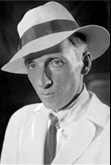|
 Valerian
Sidamon Eristavi Valerian
Sidamon Eristavi
Modernist artist, graphic artist, caricaturist,
art director and stage designer.
He was born in Kvareli, Georgia in 1889. In
1909-1915 he studies at the Moscow College of Painting, Sculpture and
Architecture. In 1915 he returns to Georgia.
In 1915-1916 he collaborates with the newspaper
“Sakartvelo” which is published under the editorship of S. Shanshiashvili,
creates caricatures and sketches on everyday-life and allegorical themes.
At the same time he works in the sphere of book
design as well.
In 1917 he travels in Erzrum and creates the
sketches of types and everyday scenes.
During these years Valerian Sidamon-Eristavi
creates the paintings of historical genre - “Queen Tamar” (1917), “Krtsanisi Battle” (1919), “Erekle II Battle with the
Lezghins” (19921-22), etc. and continues this way the thematic traditions of
the Georgian painting at the turn of the 19th-20th
centuries. It is remarked that his paintings come close to the Russian
historical painting of the same period. However, the contextual difference is
obvious: unlike the Russian one he has no intention to reflect social conflict
on one hand, and on the other hand his creative works are not based upon the
ambition of the religious or national glorification. With Sidamon-Eristavi the
context is overtly national-historical which might be connected with the lost
state independence of the country and the process of historical and
cultural-self-identity under the circumstances of new European orientation.
According to the artistic point of view his paintings during these years are
the bearers of postimpressionist and fauvist features.
Sidamon-Eristavi is the best portraitist.
IN the 1920es his paintings are expressionist,
often too dramatic, even tragic, and metaphorical, or utterly grotesque – “Attack of the Red Cavalry”,
1921; “Children in the Garden”, 1920es; “Red Sowers”, 1920es; “Old
Tbilisi. A Militiaman”; 1930es. The expressionist grotesque of his is
revealed in the art design of the film “My Grandmother”.
Though Irakli Gamrekeli’s function in this film
is the special-constructional arrangement of a still image, it is the types of
Sidamon-Eristavi that create the acute grotesque.
He works in the Georgian theatre and
cinematography and collaborates with Kote Marjanishvili. In 1922 he designs the
following performances at the Rustaveli Theatre: “The Sheep’s Spring”, “The Sun
Eclipse in Georgia”. In 1923 he is the designer of the first stage production
of Paliashvili’s opera “Daisi” (“The Sunset”) at the Opera and Ballet House in
Tbilisi while in 1924 – of the Arakishvili’s opera “Shota Rustaveli”.
From 1922 to 1935 he works as an art director.
He is the art director of about 35 films including Amo Bek-Nazarov’s film
“Patricide” (1923); Kote Marjanishvili’s films “The Gadfly” (1928) and “The
Communard’s Pipe” (1928); Kote Mikaberidze’s
film “My Grandmother” – together with Irakli Gamrekeli (1929); Mikheil
Chiaureli’s “The Last Masquerade” (1934).
From the second half of the 1930es he is mostly
engaged in humble pedagogical activities.
He died in 1943. |